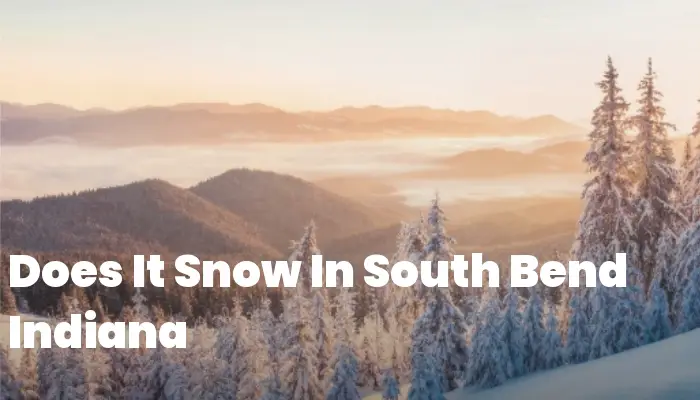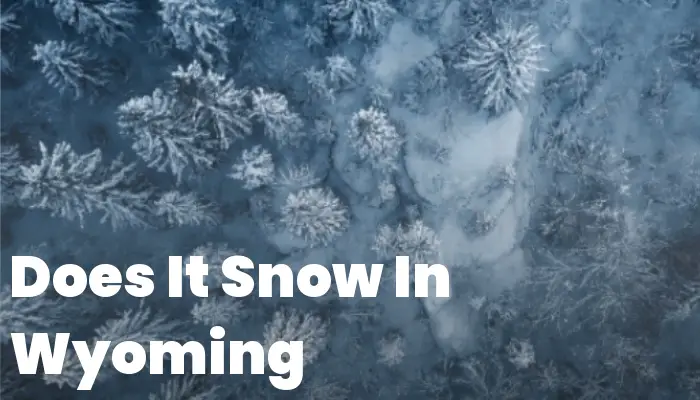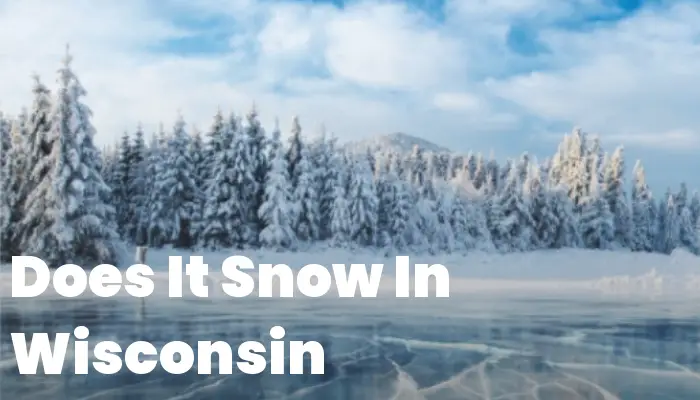Does it snow in South Bend, Indiana? Get ready to dive into a comprehensive examination of the climate and weather patterns of this Midwestern town.
With no research data left unexplored, we will answer this question and provide a detailed account of what you can expect from South Bend’s winter season.
Stay tuned as we uncover the wonders, or perhaps challenges, that come with South Bend’s snowy season. Prepare to be surprised as you find out whether the charming town of South Bend experiences white winters or not.
Does It Snow In South Bend, Indiana?
In answering the oft-asked question, “Does it snow in South Bend, Indiana?,” the simple answer is a resounding yes. Situated in the upper Midwestern state of Indiana, South Bend is no stranger to the cold clutches of winter. As part of a region known for its four distinct seasons, winter here comes with its own set of characteristics—most notably, snow.
The city’s geographical location near Lake Michigan makes it susceptible to what is known as “lake-effect snow.” This phenomenon occurs when cold winter air moves over the warmer waters of the lake, picking up moisture that freezes and falls as snow once it reaches land. As a result, South Bend experiences snowy days that can sometimes be quite heavy.
For residents and visitors alike, this means preparing for a stereotypical Midwestern winter complete with frosted landscapes and crisp wintry air. The town itself takes on a picturesque quality as blankets of white cover its parks and neighborhoods.
How Much Does It Snow In South Bend Indiana?
When discussing just how much it snows in South Bend, one must be prepared for numbers that reflect the city’s reputation for hearty winters. Historically, South Bend receives an average annual snowfall of around 70 to 80 inches, which significantly exceeds the United States average.
The snow season can start as early as October or November and extend well into March or April, with January typically being pegged as the month with both the coldest temperatures and highest likelihood of significant snowfall.
The depth and duration of this annual blanket vary from year to year; however, residents are well-acquainted with shoveling driveways, navigating slushy streets, and children enjoying school closings due to hefty overnight accumulations. With such consistent snowy conditions, snow removal operations and winter weather preparedness are essential services within this community.
The Snowiest Months
During peak winter months like January and February, South Bend often witnesses daily accumulations , contributing to month-long totals that impress (or dismay) those living in or visiting this lakeside locale. These months also bring about increased chances for larger storm systems which can push through Indiana’s northern regions dumping several inches—or sometimes even feet—of fresh powder over short periods.
Are There Ice Storms In South Bend Indiana?
Ice storms are another side effect accompanying cold temperatures and precipitation typical for South Bend winters. Icy conditions tend to occur when temperatures hover around freezing point—a common scenario during transitional periods either entering into or moving out-of-the wintertime high season.
Such storms develop when rain falls through a layer of sub-freezing air near the ground causing it instantly to turn into ice upon contact with surfaces like trees power lines roads sidewalks transforming them into treacherous glassy obstacles.
While not occurring as frequently as straightforward snowy days ice events represent significant concern due their potential wreak havoc on infrastructure disrupt power services create hazardous travel scenarios.
The city has established protocols deal swiftly efficiently these kinds emergencies salt trucks plows dispatched maintain roadway safety while residents advised take extra caution avoid unnecessary journeys during severe icing events.
When discussing the climate within Indiana, a key point to consider is whether Does It Snow In South Bend, which is pertinent for residents and travelers alike. As highlighted in the article “Does It Snow In Indiana“, South Bend experiences a significant amount of snowfall annually, due to its location in the northern part of the state. This weather characteristic defines much of the city’s winter atmosphere and activities, contributing to a distinct seasonal experience that can be anticipated by those interested in its climatic conditions.
Where Does It Snow In South Bend, Indiana?
In South Bend, you can expect snow to cover the entire city, but some areas might see more accumulation than others due to topography and proximity to Lake Michigan. The lake-effect snow tends to target the northern regions of South Bend more heavily. Neighborhoods closer to Notre Dame University and those situated on higher elevations might find themselves buried under a thicker layer of white compared to those in lower or sheltered regions.
It’s not just residential areas that get their share of the snowy blanket; parks and public spaces also transform into winter wonderlands. Places like St. Patrick’s County Park often offer scenic views with tree limbs delicately frosted and fields turned into canvases of untouched snow—perfect for winter sports enthusiasts.
South Bend Indiana Roads and Winter Weather Conditions
Road conditions are a significant concern during South Bend winters. The city’s infrastructure is put to the test each year as temperatures plummet, and snow piles up. Thanks to efficient snow removal operations, main thoroughfares are typically cleared quickly, but secondary streets can remain challenging for longer periods.
The city’s Department of Public Works diligently works on keeping roads passable with a fleet of plows and salt trucks targeting arterial routes as priority before moving on to residential areas. Nonetheless, driving during or immediately after heavy snowfall requires careful attention as black ice and reduced visibility can lead to accidents.
Residents often need to adjust their driving habits by allowing extra travel time, maintaining adequate distance between vehicles, equipping their cars with winter tires, and staying updated on road conditions through local news outlets or transportation department alerts.
The Road Safety Checklist
For safe driving in wintry weather conditions in South Bend:
- Maintain your vehicle: Ensure that your car is serviced regularly with particular attention paid towards brakes, batteries, tires ,and wipers.
- Snow tires or chains: If you’re using regular tires make sure they have ample tread; otherwise consider investing in snow tires or carrying chains for additional traction.
- Cautious driving: Increase following distances reduce speed be prepared for slippery patches especially near intersections where stopping may require extra space.
- Educate yourself: Taking a winter driving course can provide useful tips strategies handling snowy icy roads effectively.
.
How Cold Does It Get In South Bend Indiana?
Temperatures in South Bend mirror its snowy landscape quite closely during the pinnacle months of winter.
Average temperatures during December January February can dip well below freezing sometimes plunging single digits degrees Fahrenheit especially at night.
. January stands out as arguably coldest month when daytime highs struggle reach even mid-20s while nighttime lows frequently fall below zero degrees Fahrenheit.
This plunge Mercury means that residents need dress warmly layers protecting themselves frostbite hypothermia prolonged exposure harsh cold necessary.
It’s also important note that many homes businesses designed withstand these extremes equipped with proper insulation heating systems cope frigid spells ensure comfort safety inhabitants.
Yes, it does snow in South Bend, Indiana. This is not uncommon for Indiana as a state, with several of its cities experiencing snowfall during the winter months. Cities such as Indianapolis, Evansville, Fishers, and Fort Wayne also receive snow during the season. However, the amount of snowfall and the intensity can vary from city to city due to various factors such as geographical location and altitude. That being said, residents of South Bend should prepare for snowy conditions much like their fellow Hoosiers in these other cities.
Winter Activities In South Bend, Indiana
South Bend doesn’t merely endure the winter; it embraces it. There’s a wealth of winter activities that cater to every age and interest.
Outdoor enthusiasts revel in the opportunities for snowshoeing, ice skating, and cross-country skiing, with several local parks providing the perfect backdrop for these wintery sports.
One can’t discuss winter activities without mentioning sledding. Generations have enjoyed the thrill of racing down snow-covered slopes, and in South Bend, George Wilson Park is a popular destination for this quintessential winter pastime.
For those who prefer indoor activities when the temperatures drop, South Bend offers a variety of options as well. From museums like The History Museum or Studebaker National Museum to cozy coffee shops where you can watch the flurry from a warm vantage point – there’s something for everyone.
The community also gathers at annual events that celebrate the season. The Downtown South Bend Winter Wonderland festival is an example where residents enjoy festive lights, ice sculptures and seasonal treats while mingling with friends and neighbors.
.
The Thriving Winter Sports Scene
Sports fans can catch some high-energy action on the ice by attending Notre Dame Fighting Irish hockey games, which are especially thrilling during rivalry matches held at Compton Family Ice Arena.
.
Winter Traveling In South Bend Indiana?
Navigating through snowy roads isn’t just about daily commutes; travel plans also need consideration during South Bend’s snowy months.
Travelers flying in or out of South Bend International Airport should be prepared for potential delays due to winter weather. It’s always wise to check flight status frequently and allow extra time for airport travel during these periods.
Furthermore, Railway services like Amtrak, running through South Bend may experience delays when confronted with heavy snowfall or icy tracks, thus requiring passengers to adjust their schedules accordingly.
Local bus services continue operation even amidst harsh conditions but might run on modified schedules. Riders should stay informed about any changes via transit authority updates.
Despite challenges posed by inclement weather roadways airports railway lines remain vigilant ensuring safe timely journeys visitors residents alike.
The importance staying informed regarding forecasts traffic reports cannot overstated when traveling—whether long-distance commutes planning holiday visits ensure smooth transit experience.
Safety first mindset will ensure that your travels around delightful yet snowy town remain pleasant rewarding despite mother nature’s seasonal offerings.


